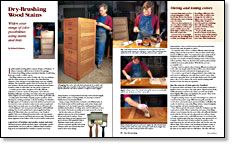Dry-Brushing Wood Stains
Widen your range of color possibilities using stains and tints
Synopsis: Roland Johnson took on the challenge of refurbishing a set of filing cabinets. His finishing challenges were matching new white oak to the aged patina of the original case and making red oak look like aged white oak. Dry-brushing is a two-step process that begins with traditional staining. The method leaves pigment on the surface of the wood as well as in the pores. You’ll need a good set of brushes and quality stains and tints to follow his example. Just the topcoat of stain gets dry brushed. Johnson clearly explains each step, down to spraying on a protective finish. He also includes side information on tinting and toning colors.
I pride myself on being able to restore all types of furniture. So when a customer called on me to look at two grungy, broken-down filing cabinets and asked whether I could bring them up to snuff, I couldn’t say no.
The filing cabinets were made of white oak. One was missing a side; the other needed two new sides. The client liked the character of the old pieces but realized they were not valuable antiques. She wanted the repairs done for less than the cost of new cabinets. We discussed options and agreed the new frames would be made of solid white oak, the panels of plywood.
I couldn’t get the white oak plywood locally. With the customer’s consent, I used red oak panels. I now had two finishing challenges: matching new white oak to the aged patina of the original case and making red oak look like aged white oak.
To help make these kinds of repairs appear seamless, I have developed a staining technique I call dry brushing. I’ve blended the light sapwood of walnut to match the dark brown heartwood. I’ve used it to even out hard-to-stain woods such as maple and cherry. And I can make new wood look like it’s 100 years old.
Dry brushing is a two-step process that begins with traditional staining: The wood is sanded and a stain is applied and then wiped off. When that’s dry, a second, heavy coat of stain is applied. This coat is delicately brushed with a soft, dry, natural bristle brush to remove and blend any excess stain. This method leaves pigment on the surface of the wood as well as in the pores.
A good set of brushes and quality stains and tints
The brush must be pliable and have dense, soft bristles. I prefer natural bristles, but you could use a different kind of brush as long as it’s recommended for varnish or enamel. Don’t buy cheap brushes; an inexpensive brush may seem soft and supple, but it will be prone to losing bristles. It’s not easy to remove bristles from a dry-brushed finish.
From Fine Woodworking #123
For the full article, download the PDF below:



















Log in or create an account to post a comment.
Sign up Log in